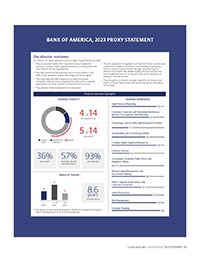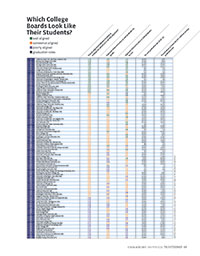
We recently examined the degree of racial and gender alignment between the governing boards and the undergraduate student populations at 100 higher education institutions across the country—large and small, public and private, highly ranked and less regarded. We presented the results in the September/October 2023 issue of Washington Monthly, in an article entitled, “Does Your Board of Trustees Reflect Your Student Body?”1 The data we collected are included in the table inserted below.
During this study, we came to a stark realization. Not one college or university among the 100 schools in the study posted its board’s demographics on the institution’s website. Some had lists of members, others had pictures, but none presented data on race and gender for their trustees, individually or collectively. As a result, we had to deploy research assistants for weeks to review photos, surf LinkedIn, and consult the websites of organizations and companies cited in trustees’ biographies. (Prior experience suggested that direct requests to the colleges would often be disregarded or not obliged).
By contrast, we were quickly able to obtain detailed race and gender numbers and percentages for each institution’s students after just a few clicks on the school’s “fact book” page or via the National Center for Education Statistics, a federal database. Even more noteworthy, proxy statements—readily accessible online for publicly traded companies—commonly include race, gender, and often age for members of the board of directors as a whole and often for individuals. Within a minute or two on corporate websites, we could view easy-to-grasp charts and graphs of board members’ demographics for scores of companies such as Apple, Bank of America, Procter & Gamble, and Williams-Sonoma to name only a few; some proxies even delineate each director’s pertinent skills. (See the sidebar for examples and links).
This raises the obvious question: “Why is the demographic composition of college boards so opaque?” If demographic disclosures are standard practice for publicly traded companies, why not for colleges and universities, institutions presumably as committed to transparency as for-profit corporations?
Should not stakeholders and the public at large be able to assess whether college boards have trustees with varied and relevant backgrounds, experiences, and expertise, much as investors can evaluate the rosters of corporate boards? Would it not be useful for students, parents, grant-makers, and donors to know whether the demographics of an institution’s trustees reflect the demographics of its students? Alignment on that dimension does not guarantee that a board will be attuned to its students’ perspectives and needs, but surely the odds are better with a greater degree of symmetry.
We are not recommending that boards establish quotas or reserve seats for any category of trustee (likely to be unlawful anyway), except when that may be required by state statute or institutional bylaws. Rather, we are proposing that college and university governing boards exemplify transparency and demystify their board’s demography. This starts with posting and publishing straightforward aggregate data on the trustees’ race, gender, and age—a simple reform long overdue.
Which colleges and universities will lead the way?
Richard Chait, PhD, is professor emeritus of higher education at Harvard University.
Raquel Rall, PhD, is associate professor of education policy analysis and leadership at the University of California, Riverside.
Demetri Morgan, PhD, is associate professor of higher education at Loyola University Chicago.
Notes
1. Raquel M. Rall, Demetri L. Morgan, and Richard Chait, “Does Your Board of Trustees Reflect Your Student Body?” Washington Monthly September/October 2023 (August 27, 2023); https://washingtonmonthly.com/2023/08/27/does-your-board-of-trustees-reflect-your-student-body/.
Disclosure of Demographic Composition by Corporate Boards
Bank of America
https://investor.bankofamerica.com/2023-proxy-statement, Page 12
Proctor and Gamble
Apple
Williams-Sonoma
https://www.sec.gov/Archives/edgar/data/719955/000162828023011620/wsm-20230414.htm, Page 19
RELATED RESOURCES

Trusteeship Magazine Article
Diverse, Inclusive, and Equitable Boards:
A Dozen Ideas to Make Progress

Trusteeship Magazine Article
Creating Inclusive Board Cultures

Trusteeship Magazine Article
Diverse, Inclusive, and Equitable Boards:
Why So Slow?




